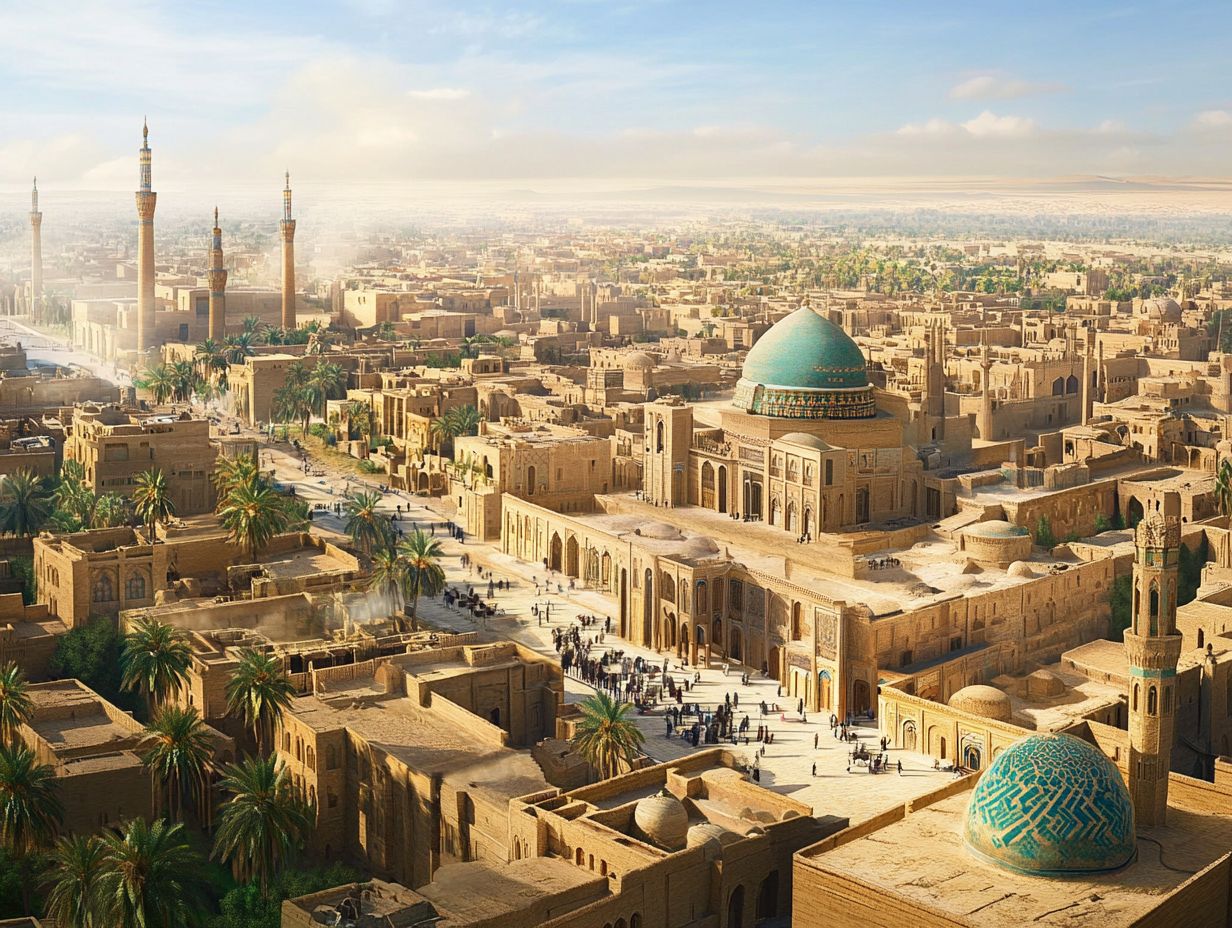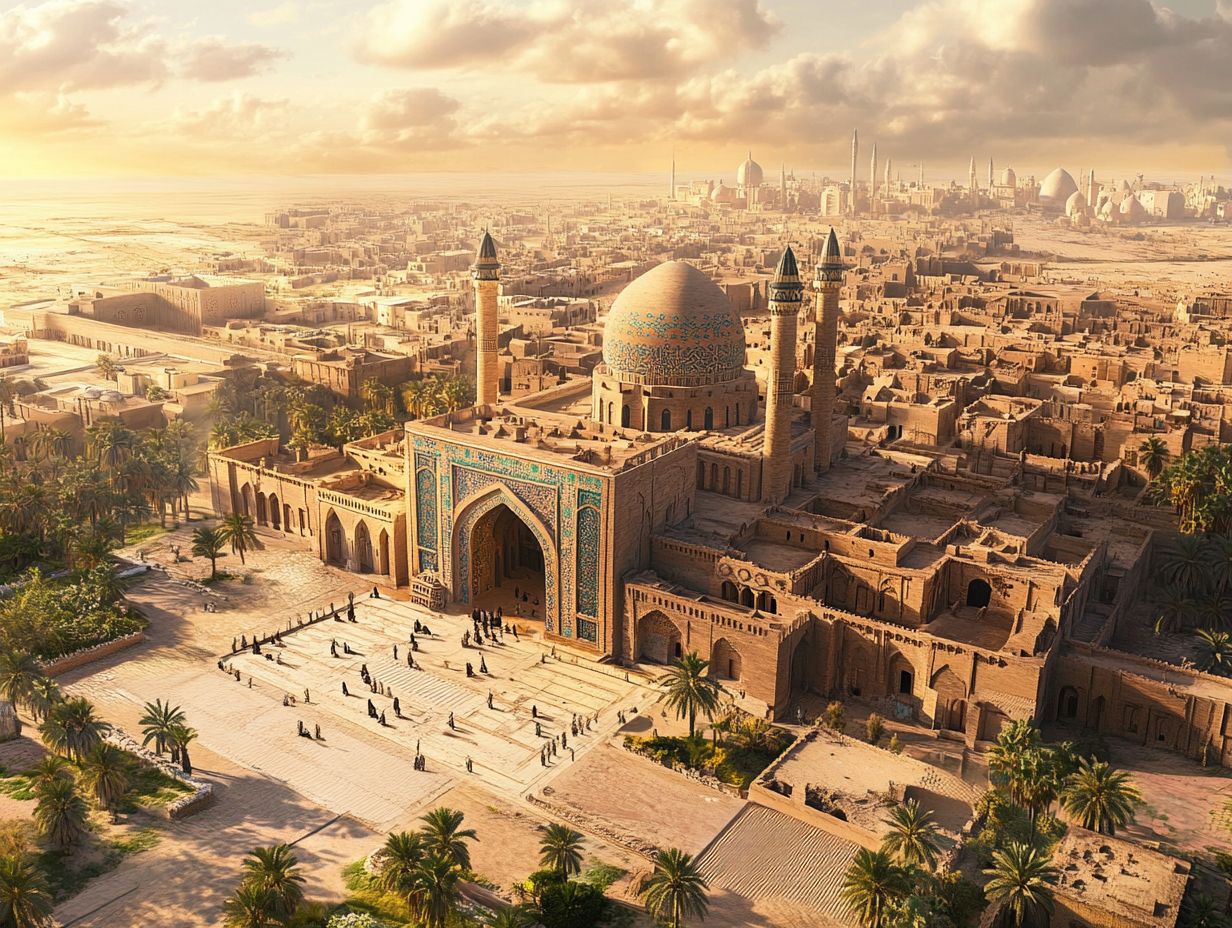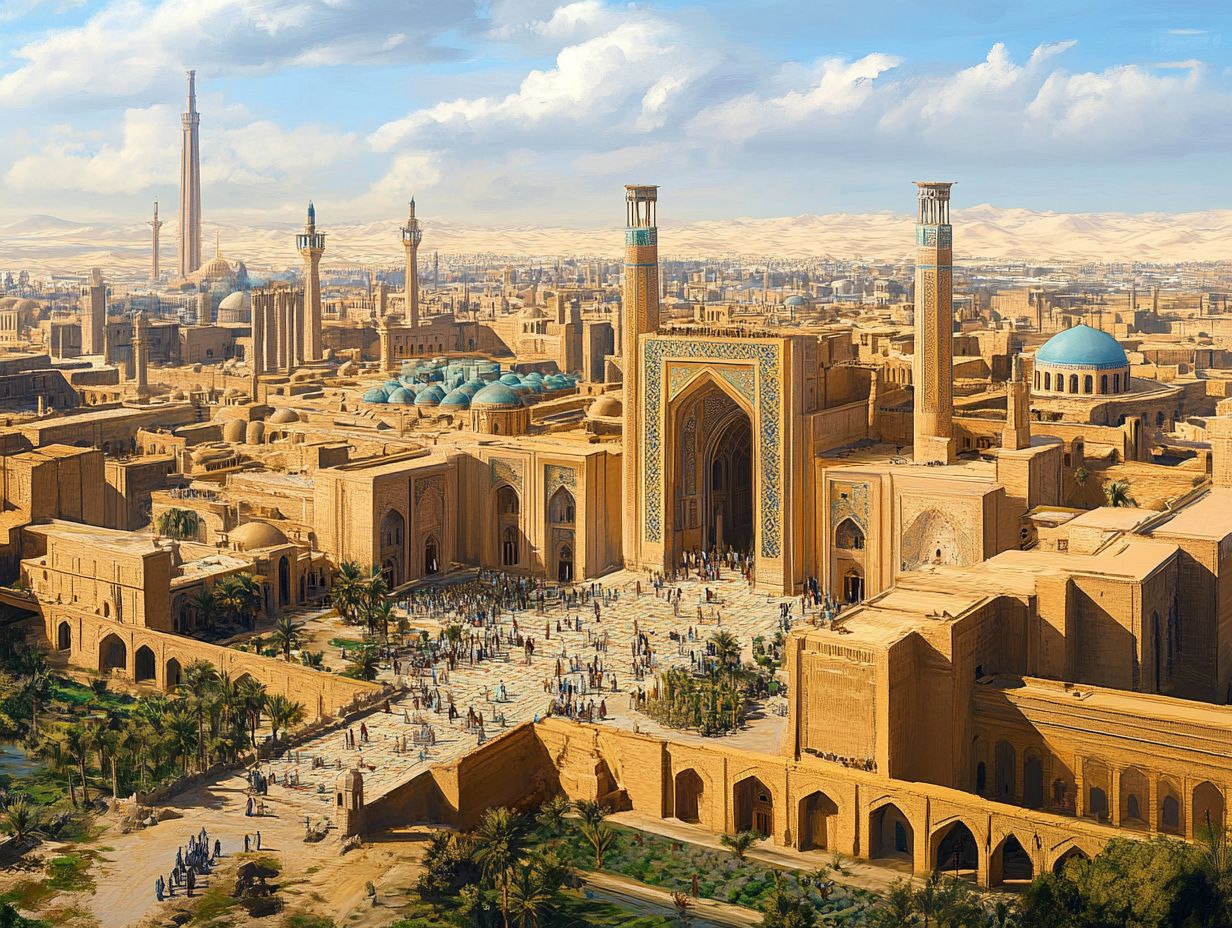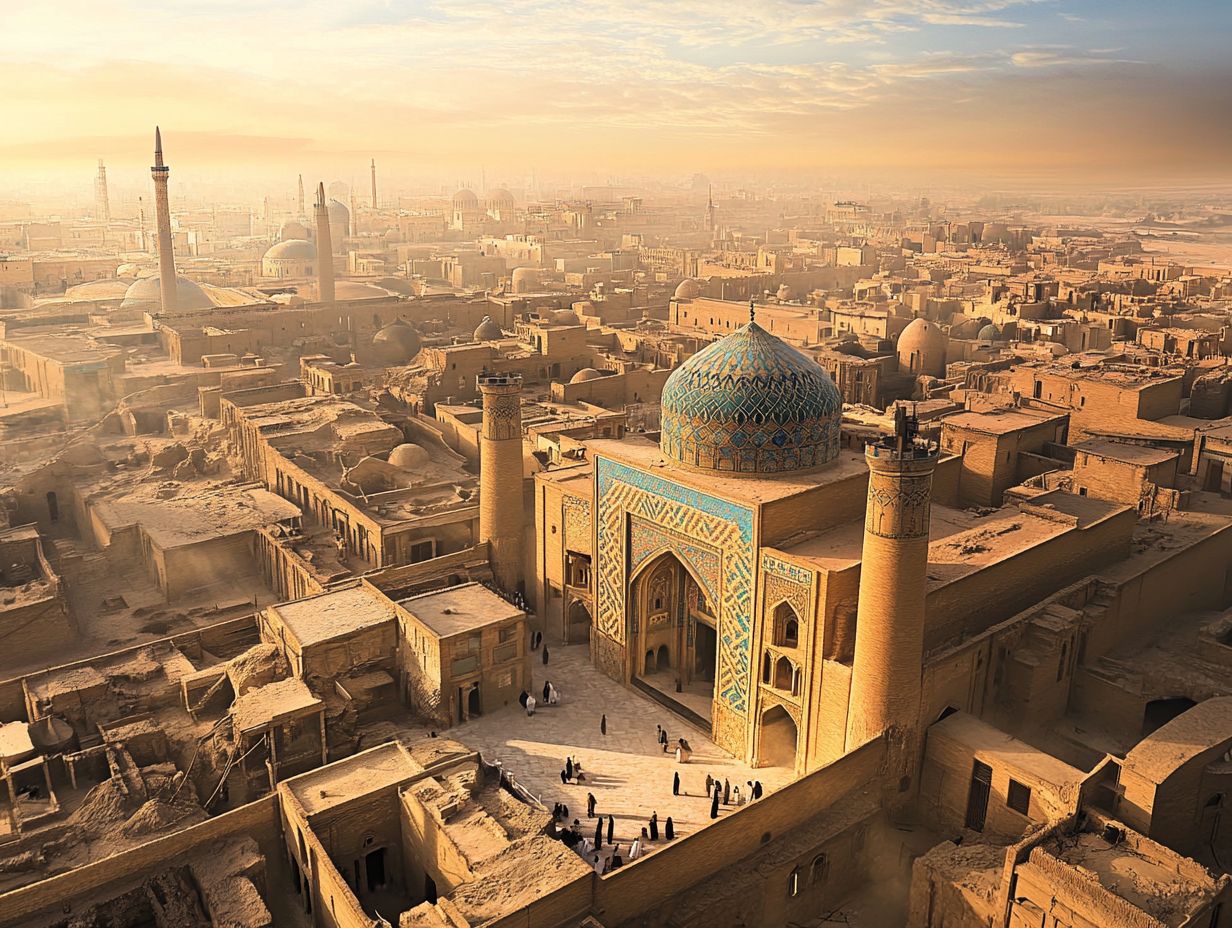
Historical Context
Overview of Iraqi Architecture and Buildings
Posted on August 22, 2024 in Politics
Iraqi architecture is a fascinating tapestry that combines ancient traditions and modern innovations, reflecting the rich history and diverse cultures of the region.
From the awe-inspiring structures of Mesopotamia to the intricate designs influenced by Islamic and Ottoman architecture, this overview explores the evolution of Iraqi buildings through the ages.
Notable examples, the impact of historical events, and contemporary trends shaping the future of architecture in Iraq are discussed.
This journey through architectural heritage highlights the significance of preservation and innovation in a rapidly changing world.
Historical Context

A comprehensive understanding of the historical context of Iraqi architecture necessitates an exploration of the diverse influences that have shaped its architectural heritage over the centuries, ranging from ancient Mesopotamian structures to contemporary innovations.
Throughout its history, Iraq has served as a crossroads for various civilizations, each contributing to the rich tapestry of its architectural narrative through unique styles and building typologies.
The architectural evolution observed in Iraq is a testament to its resilience and adaptability, with historical monuments serving as enduring symbols of the cultural traditions and transformations that have unfolded over time.
Overview of Mesopotamian Architecture
Mesopotamian architecture, recognized as one of the earliest forms of architectural expression, features a diverse array of complex structures that fulfilled various social functions within ancient civilizations. Characterized by monumental buildings constructed primarily of mud-brick and later stone, Mesopotamian architecture established a foundational influence for subsequent architectural innovations in the region.
The architectural elements of Mesopotamia, including ziggurats, temples, and palaces, not only highlight the artistic and technological advancements of the era but also reflect the cultural and religious practices of the societies that produced them.
This architectural legacy is manifested in the use of colossal structures that showcased the power of city-states, alongside intricate layouts designed to accommodate public gatherings and rituals. Notable examples, such as the Ziggurat of Ur, illustrate how these towering edifices served dual purposes as temples and symbols of societal hierarchy.
The techniques employed, including the corbel arch and the development of fortified city walls, significantly influenced various architectural styles across different cultures. Furthermore, the emphasis on urban planning in Mesopotamian cities has resonated throughout history, highlighting the critical role of architecture in shaping communal life and governance.
Islamic Architectural Influence
Islamic architecture has had a profound impact on the architectural landscape of Iraq, introducing a diverse array of styles and decorative arts that have significantly enriched the region’s heritage over the centuries. The grand mosques, adorned with intricate tile work, and the serene courtyards of madrasahs serve as reflections of the spiritual and cultural dimensions of Islamic civilization.
As architectural innovation flourished, elements such as arches, domes, and minarets became defining features of the skylines of cities like Baghdad, showcasing a blend of artistic expressions influenced by both Islamic and Persian traditions.
This transformation is particularly evident in significant monuments such as the Great Mosque of Samarra, whose striking spiral minaret exemplifies both strength and elegance, and the remarkable Al-Mustansiriya University, which embodies the intellectual spirit of the Islamic Golden Age.
Furthermore, the interplay between architecture and Persian poetry has notably shaped these designs, with verses celebrating beauty and spirituality inspiring patterns and motifs that adorn walls and ceilings.
These artistic elements serve not only decorative purposes but also convey deeper religious and cultural narratives, thereby enriching the collective memory of the Islamic world and leaving an indelible mark on the region’s identity.
Early Caliphate Contributions
The contributions of the early Islamic Caliphates to architecture are crucial for understanding the evolution of Iraqi architecture, particularly during the Umayyad and Abbasid periods, which introduced significant architectural innovations. This era witnessed the emergence of new building typologies, such as mosques and palaces, purposefully designed to embody the power and prestige of the Caliphate.
The architectural elements from this period, including the intricate use of geometric patterns and calligraphy, served not only aesthetic purposes but also enhanced the religious and cultural significance of the structures.
The Umayyad Caliphate established the groundwork for these advancements with remarkable constructions such as the Great Mosque of Damascus, which set a standard for mosque architecture throughout the region. This mosque, featuring its grand courtyard and exquisite mosaics, had a profound influence on subsequent church designs.
In the following period, the Abbasids redirected the architectural focus, exemplified by the construction of the Great Mosque of Samarra, renowned for its monumental minaret, the Malwiya, which adeptly combined functionality with symbolism. These grand structures not only fulfilled religious functions but also evolved into cultural centers that promoted trade, learning, and community engagement.
Consequently, they played a pivotal role in shaping the architectural identity of Iraq and left an enduring legacy on later Islamic artistic expressions.
Umayyad and Abbasid Achievements
The Umayyad and Abbasid dynasties represent a significant period characterized by exceptional achievements in architectural heritage, with both dynasties making enduring contributions to the cultural and historical landscape of Iraq.
Umayyad architecture is particularly noted for its monumental structures and decorative arts, as exemplified by the Great Mosque of Damascus, which has had a profound influence on subsequent mosque designs in Iraq. In contrast, the Abbasid period is distinguished by the establishment of Baghdad as a prominent center of learning and culture, where architectural masterpieces such as the House of Wisdom epitomized the advanced knowledge and artistic vitality of the era.
These dynasties expanded the boundaries of architectural design through innovations such as intricate arabesques and elaborate minarets, which became hallmark features of Islamic architecture. The Umayyads, for instance, skillfully integrated elements from Roman and Byzantine styles, resulting in a distinctive synthesis that set a precedent for future constructions. Conversely, the Abbasids further advanced this legacy with iconic structures like Al-Mansur’s circular city, exemplifying strategic urban planning.
These achievements not only influenced local architectural styles but also generated interest across various regions, leaving a lasting impact on the architectural evolution of the Islamic world and inspiring subsequent generations to explore and innovate within this rich cultural framework.
Ottoman Influence on Iraqi Architecture
The influence of Ottoman architecture on Iraq is marked by a series of architectural transformations that introduced new styles and building techniques, significantly impacting the urban landscape. During the Ottoman period, architectural motifs and grand public works, including mosques and schools, reflected the empire’s administrative power and cultural aspirations while fostering community engagement within urban environments.
The integration of traditional Islamic elements with Ottoman design resulted in a distinctive architectural expression that continues to define Iraq’s historical monuments.
Structures such as the Great Mosque of Kufa and the Mustansiriya School exemplify this synthesis, showcasing intricate tilework and expansive courtyards that facilitated communal gatherings. These edifices functioned not only as places of worship and education but also as pivotal centers for social interaction, creating a sense of belonging among the population.
The incorporation of architectural features such as domes, minarets, and intricate carvings not only enhanced the aesthetic appeal of the buildings but also reinforced Iraq’s cultural identity during a period of significant Ottoman influence. This rich architectural heritage has left an enduring mark on Iraq, shaping the ethos of its communities for generations.
Modern Iraqi Architecture
Modern Iraqi architecture exemplifies a dynamical interplay between historical influences and contemporary architectural innovations, particularly noticeable in the developments that emerged after 1958. This period signified a substantial transformation in architectural design, shaped by the prevailing political landscape and cultural heritage.
As a result, a diverse range of building types has emerged, reflecting the aspirations of a burgeoning urban middle class. The integration of traditional forms with modern techniques has led to the creation of distinctive structures that not only address the socio-political context but also pay tribute to Iraq’s rich architectural legacy.
The Kingdom of Iraq Era

The Kingdom of Iraq era, which spanned from 1921 to 1958, represented a pivotal period for architectural development. This era was marked by the emergence of modern design principles and urban patterns that sought to reconcile traditional aesthetics with contemporary influences.
During this time, the incorporation of local materials and craftsmanship became increasingly significant. This approach enabled structures to resonate with the region’s cultural heritage while simultaneously accommodating modern functionality. Architects aimed to create buildings that fulfilled both public and private purposes, serving as symbols of national pride.
This synthesis is exemplified in projects such as Al-Mustansiriya University, where traditional Islamic architectural motifs coexisted harmoniously with modern educational infrastructure.
This dynamic phase laid the foundation for future architectural movements, cultivating a distinctive identity within Iraqi architecture that continues to be recognized and celebrated today.
Post-1958 Architectural Developments
Post-1958 architectural developments in Iraq represent a significant response to the evolving political landscape and socio-economic conditions, resulting in a wave of innovative architecture aimed at addressing urban needs and aspirations. This period witnessed the emergence of modernist architecture, with architects exploring new materials and forms to create spaces that were both functional and aesthetically appealing.
The integration of contemporary design principles with traditional elements established a distinctive architectural language that resonated with the Iraqi populace, fostering a sense of identity and continuity within a rapidly changing environment.
During this transformative era, urban planners and architects increasingly prioritized not only aesthetic considerations but also the functionality and sustainability of public spaces. The emergence of large-scale projects, such as civic centers and educational institutions, underscored a vision of modern living that emphasized community interaction and urban renewal.
Architects drew inspiration from global modernist movements while incorporating local motifs, thereby cultivating a unique architectural identity. Innovations such as reinforced concrete and cutting-edge façades facilitated the creation of structures that symbolized progress and adaptability, aligning with societal aspirations for a brighter and more interconnected future.
Shifts in Design and Style
Shifts in design and style within Iraqi architecture serve as indicators of broader cultural and social changes. Architects and designers are increasingly navigating the complexities of modernity while maintaining a connection to traditional aesthetics.
Contemporary innovations have introduced new materials and techniques, facilitating greater flexibility in architectural composition and enhancing aesthetic considerations. This evolution is evident in various building types, ranging from public institutions to private residences, which exemplify a balance between historical reverence and modern functionality.
For example, the juxtaposition of ornate Islamic arches with sleek glass facades in urban projects exemplifies the synthesis of traditional and contemporary elements. The integration of sustainable design principles has gained prominence, leading to the incorporation of eco-friendly materials and energy-efficient systems within structures that honor their cultural heritage.
Architectural expressions are now increasingly influenced by a desire for community-oriented spaces, resulting in the inclusion of communal areas and gardens in residential designs. Consequently, the outcome is a dynamic architectural language that not only demonstrates aesthetic sophistication but also addresses the evolving needs of the Iraqi populace, reflecting a society in transition yet deeply rooted in its heritage.
Notable Examples of Iraqi Architecture
Notable examples of Iraqi architecture exemplify the diverse architectural heritage that extends from ancient to modern times, reflecting the multifaceted identity of the nation. The architectural landscape ranges from the iconic structures of early Islamic and Mesopotamian architecture to contemporary landmarks, with each building embodying a narrative of cultural significance and historical importance.
This section explores specific architectural examples that illuminate the richness of Iraq’s built environment and its evolution over time, including traditional courtyard houses, religious edifices, and modern developments.
Traditional Courtyard Houses
Traditional courtyard houses in Iraq exemplify a distinct architectural typology that encapsulates cultural traditions and social functions, reflecting the values and lifestyles of their inhabitants. These residences are characterized by an inward-facing design, typically featuring a central courtyard that provides a private outdoor area for family gatherings and social interactions. The architectural elements of these homes, including thick walls and decorative features, offer valuable insights into the historical climate considerations and aesthetic preferences of the Iraqi people.
Beyond serving as mere shelter, these houses function as social hubs where families can strengthen their relationships and engage with guests, underscoring the significance of hospitality in Iraqi culture. The layout promotes community interaction while preserving the privacy of family life, facilitating a harmonious blend of public and private spaces.
The utilization of local materials, such as mud bricks, not only reflects the environmental adaptations of the region but also signifies a deep connection to heritage and craftsmanship. This architectural style, firmly rooted in tradition, continues to resonate with contemporary Iraqi society, illustrating how historical practices can inform modern living.
Religious Structures: Mosques and Shrines

Religious structures, including mosques and shrines, are fundamental to Iraq’s architectural heritage, reflecting the intricate artistry and spiritual significance inherent in these buildings.
These edifices often represent centuries of history and the confluence of various cultural influences that have shaped the region. The Great Mosque of Samarra, with its iconic spiral minaret, exemplifies the brilliance of medieval Islamic architecture, emphasizing that these structures serve not only as preservers of faith but also as essential landmarks that anchor communities.
Similarly, the Imam Ali Shrine in Najaf showcases elaborate tile work and historical depth, attracting both pilgrims and visitors. These notable examples demonstrate how mosques and shrines are profoundly interconnected with cultural identity and community cohesion, functioning as symbols of resilience and continuity within Iraq’s evolving narrative.
Modern Landmarks and Buildings
Modern landmarks and buildings in Iraq exemplify the country’s architectural expressions that resonate with contemporary sensibilities while honoring historical narratives. The emergence of innovative design practices has resulted in the creation of iconic structures, such as the Al-Shaheed Monument and other significant public buildings, which symbolize Iraq’s aspirations for the future.
These modern landmarks frequently incorporate advanced materials and design principles, reflecting a commitment to architectural innovation within a complex socio-political landscape.
The National Museum of Iraq, recently renovated, serves as a testament to the nation’s rich cultural heritage while embracing modern architectural trends. With sleek lines and open spaces that promote public interaction, these structures are designed to foster a sense of community, bridging the gap between Iraq’s storied past and its progressive future.
Notably, the Erbil Citadel, a UNESCO World Heritage Site, showcases an intriguing blend of ancient and contemporary influences, illustrating how modern architecture can coexist harmoniously with historical landmarks. This integration of innovative design not only enhances the urban landscape but also instills a renewed sense of national pride and identity among the Iraqi people.
Architectural Challenges and Innovations
Architectural challenges and innovations have profoundly influenced the development of Iraqi architecture, especially in light of historical upheavals, including war and conflict. The repercussions of these challenges have not only jeopardized architectural heritage but have also prompted a series of innovative initiatives focused on preserving and revitalizing Iraq’s rich architectural legacy.
In addressing these challenges, architects and urban planners are exploring new methodologies and design paradigms that respect historical context while simultaneously meeting contemporary requirements.
The Impact of War on Architectural Heritage
The impact of war on Iraq’s architectural heritage has been significant, leading to the destruction and neglect of numerous historical monuments that once served as testaments to the nation’s rich cultural tapestry. This destruction not only eradicates physical structures but also undermines the cultural memory and identity associated with these sites.
Preservation efforts have emerged as vital initiatives aimed at documenting, restoring, and protecting Iraq’s architectural heritage, thereby ensuring that the legacy of its historical monuments remains intact for future generations.
Over the years, landmarks such as the iconic Al-Nuri Mosque in Mosul, renowned for its leaning minaret, have been tragically lost to conflict, exemplifying the devastating toll of warfare on these invaluable symbols of Iraqi history. The extensive archaeological treasures of ancient Babylon and Nimrud have faced significant threats from both looting and airstrikes, underscoring the urgent need for preservation initiatives.
In response to these challenges, various organizations and local entities are actively engaged in efforts to safeguard these sites through documentation, educational programs, and community engagement. These initiatives foster a sense of ownership and pride in Iraq’s rich cultural legacy. Such efforts are crucial not only for the preservation of physical structures but also for the continuity of cultural heritage amidst the complexities of modern-day conflicts.
Contemporary Innovations in Iraqi Architecture

Contemporary innovations in Iraqi architecture exemplify the resilience and creativity of architects and designers who are committed to redefining the built environment in the face of various challenges. These innovations are characterized by a harmonious fusion of modern architectural principles with traditional elements, emphasizing sustainable practices and actively involving communities in the design process.
Architects are increasingly concentrating on the creation of functional spaces that encourage social interaction and cultural expression, leading to structures that resonate with the needs and aspirations of contemporary Iraqi society.
A notable example of this approach is the utilization of locally sourced materials and techniques, which not only preserves cultural heritage but also minimizes environmental impact. Projects such as Basra Sports City exemplify this integration of heritage and modernity, showcasing traditional motifs alongside innovative design elements.
Additionally, participatory design initiatives have emerged, enabling local communities to influence the architectural process. This collaboration results in spaces that are both pertinent and reflective of community identity. Such partnerships are crucial in fostering a sense of ownership and pride among residents, thereby enhancing urban cohesion and promoting sustainable development.
Future of Iraqi Architecture
The future of Iraqi architecture stands at a pivotal juncture, characterized by the convergence of emerging trends and architectural aspirations that are set to redefine urban development. As Iraq progresses in its recovery from historical challenges, there is an increasing focus on sustainable practices and community-oriented design.
This reflects a collective aspiration for structures that not only fulfill functional requirements but also enhance social cohesion and cultural identity. The incorporation of modern technologies and innovative methodologies is anticipated to significantly transform Iraq’s architectural landscape in the years ahead.
Current Trends and Future Directions
Current trends in Iraqi architecture illustrate a dynamic landscape shaped by the intersection of contemporary design practices and the rich cultural heritage that characterizes the nation. Architects are increasingly adopting innovative approaches that prioritize sustainability and community engagement, resulting in a reimagined urban planning framework that reflects local identities and needs.
The future direction of architecture in Iraq seeks to create resilient and adaptable spaces that honor historical context while anticipating the demands of a rapidly evolving society.
This evolution is significantly driven by a collective desire for environments that promote social interaction and celebrate tradition, all while incorporating modern functionality. A notable emphasis on eco-friendly materials and energy-efficient techniques underscores a strong commitment to environmental stewardship.
As urban centers expand, the integration of public spaces, parks, and amenities becomes essential for maintaining a balance between urbanization and community well-being.
Consequently, the architectural narrative in Iraq is progressing toward a harmonious blend of innovation and heritage, effectively addressing both the practical needs of its inhabitants and their cultural aspirations.
The Role of Architecture in Urban Development
The role of architecture in urban development is of paramount importance, as it significantly shapes both the physical and social fabric of Iraqi cities, influencing community planning and interactions. Architectural expressions not only establish the aesthetic character of urban environments but also play a critical role in enhancing social cohesion and functionality.
As urban development advances, architects are charged with the responsibility of creating designs that resonate with the cultural values of the community while simultaneously addressing contemporary urban challenges.
In this context, the architectural landscape in Iraq increasingly mirrors a synthesis of traditional motifs and modern functionality, effectively catering to the evolving needs of its inhabitants. For example, the integration of open public spaces and communal areas encourages engagement among residents, bridging gaps that may exist in densely populated urban settings.
Structures that prioritize sustainability and environmental consciousness are particularly relevant, reflecting a commitment to both heritage and innovation. Landmark establishments, such as the National Museum in Baghdad, serve not only educational purposes but also function as cultural hubs, reinforcing a sense of identity and pride among citizens.
As architects in Iraq continue to navigate these complexities, their contributions will remain vital in promoting community development and fostering social interactions.
Summary of Architectural Significance
The architectural significance of Iraq is profoundly intertwined with its historical context and cultural identity, presenting a diverse array of styles and influences that collectively narrate the story of a nation shaped by various civilizations. From the earliest Mesopotamian structures to the intricate designs of Islamic architecture, each era contributes to a rich architectural heritage that reflects the values, aspirations, and resilience of the Iraqi people.
This summary underscores the importance of preserving and understanding this architectural legacy, as it continues to play a crucial role in defining Iraq’s identity and future.
The preservation of this architectural heritage transcends mere conservation; it is vital for fostering a sense of belonging and continuity among both current and future generations. Each structure stands as a testament to the cultural dialogues that have unfolded throughout history, emphasizing the interplay of diverse influences that have come to characterize the region.
Efforts to safeguard these historical treasures are essential for maintaining the cultural narrative and ensuring that the stories of the past are conveyed to subsequent generations.
By recognizing and appreciating this architectural significance, one can understand how these buildings serve as a bridge connecting the past to the present, ultimately shaping the national character and enriching the collective identity of the Iraqi populace.
Call for Preservation and Innovation
In reflecting upon the architectural journey of Iraq, it becomes imperative to advocate for both preservation and innovation as critical necessities for safeguarding the nation’s rich cultural heritage while accommodating future developments. The interplay between maintaining historical structures and promoting architectural innovation is vital for creating a built environment that honors the past while addressing the evolving needs of society. Engaging communities and stakeholders in this process will ensure that Iraq’s architectural legacy continues to inspire and resonate with future generations.
The diverse architectural narrative of Iraq includes remarkable ancient sites, such as the majestic ziggurats and intricately designed mosques, which not only exemplify the ingenuity of past civilizations but also serve as catalysts for modern interpretations. Balancing respect for these historical treasures with the integration of contemporary designs presents unique challenges and opportunities for architects and urban planners.
By involving local communities in discussions about their built environment, the pursuit of innovation can be harmoniously aligned with traditional values, resulting in spaces that honor history while fostering creativity.
It is therefore essential for architects, policymakers, and citizens to collaborate, ensuring that the preservation of Iraq’s architectural heritage is in concert with visions for an innovative future. This endeavor necessitates active participation and dedicated advocacy from all sectors, underscoring the importance of a sustained commitment to safeguarding the essence of Iraqi architecture.
